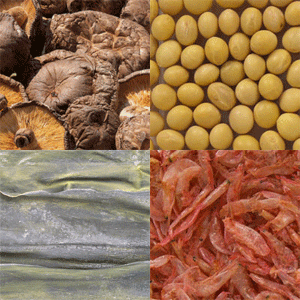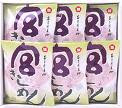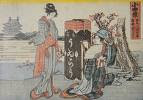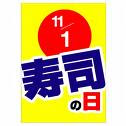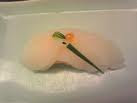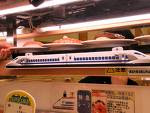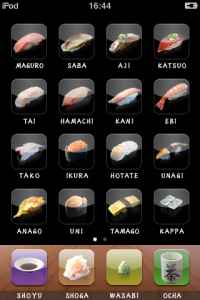::::::::::::::::::::::::::::::::::::::::::::::::::::::::::::::::::::::::::::::::::::::::::::::::::::
Miso paste and soup
***** Location: Japan
***** Season: See below
***** Category: Humanity
*****************************
Explanation
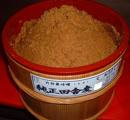
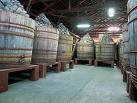
. temae miso 手前味噌 home-made miso paste .
Miso (みそ or 味噌) is a traditional Japanese food produced by fermenting rice, barley and/or soybeans, with salt and the fungus kōjikin (麹菌, koojikin) (the most typical miso is made with soy). The typical result is a thick paste used for sauces and spreads, pickling vegetables or meats, and mixing with dashi soup stock to serve as miso soup called Misoshiru (味噌汁), a Japanese culinary staple.
High in protein and rich in vitamins and minerals, miso played an important nutritional role in feudal Japan. Miso is still very widely used in Japan, both in traditional and modern cooking, and has been gaining world-wide interest. Miso is typically salty, but its flavor and aroma depend on various factors in the ingredients and fermentation process. Different varieties of miso have been described as salty, sweet, earthy, fruity, and savoury, and there is an extremely wide variety of miso available.
mugi (麦): barley, mugi-miso, Gerste-Miso
tsubu (粒): whole wheat/barley
aka (赤): red, medium flavor, most commonly used
hatchō, hatchoo (八丁): aged (or smoked), strongest flavor
shiro (白): rice, sweet white, fresh
shinshu: rice, brown color
genmai (玄米): brown rice
awase (合わせ): layered, typically in supermarket
moromi (醪): chunky, healthy (kōji is unblended)
nanban (南蛮): chunky, sweet, for dipping sauce
inaka (田舎): farmstyle
taima (大麻): hemp seed
sobamugi (蕎麦): buckwheat
hadakamugi (裸麦): rye
meri (蘇鉄): made from cycad pulp, Buddhist temple diet
gokoku (五穀): "5 grain": soy, wheat, barley, proso millet, and foxtail millet
Many regions have their own specific variation on the miso standard. For example, the soybeans used in Sendai miso are much more coarsely mashed than in normal soy miso.
Saikyoo さいきょうみそ (西京味噌) white sweet miso from Western Kyoto
Miso made with rice (including shinshu and shiro miso) is called kome miso.
Soya miso is used to make a type of pickle called "misozuke".
These pickles are typically made from cucumber, daikon, hakusai, or eggplant, and are sweeter and less salty than the standard Japanese salt pickle. Barley miso, or nukamiso (糠味噌, nukamiso), is used to make another type of pickle. Nukamiso is a fermented product, and considered a type of miso in Japanese culture and linguistics, but does not contain soya, and so is functionally quite different. Like soya miso, nukamiso is fermented using kōji mold.
© More in the WIKIPEDIA !
akamiso, red miso, about 70% soybeans and 30% rice or barley
amamiso あまみそ / 甘みそ sweet miso
Usually made from kome kooji and less salt added. For example the white miso from Kyoto and Hiroshima. Edo Amamiso. Used often for nerimiso to mix with other foods.
. . . CLICK here for Photos !
shiso-iri amamiso しそ入りあまみそ with perilla leaves
Kinzanji miso, 径山寺味噌/ 金山寺味噌 with fermented vegetables and ginger
(originates in China at the mountain temple, brought back by monk Kakushin during the Kamakura period and started producing it at Yuasa, Kishuu province.
kuro-miso, 黒味噌 black miso. not very common
Kyozakura miso, red miso from Kyoto
namemiso, "finger licking" miso
nerimiso, sweet simmered miso
nukamiso, Reiskleien-Miso
nukamiso zuke, in Reiskleien-Miso Eingelegtes
koji, kooji 麹 fermentation starter for miso
Kooji-Pilzkultur
different tasts with miso
goma-miso mit geriebenem Sesam
karashi-miso mit scharfem japanischem Senf
kurumi-miso mit Walnusspaste
negi-miso mit Lauch
neri-miso, „gerührte Miso“. Miso-Paste wird mit Reiswein, Zucker und Wasser aufgerührt.
su-miso mit Essig
yuzu-miso mit Yuzu-Zitronen
ninniku miso くにんにく味噌 / miso ninniku 味噌ニンニク
miso paste mixed with garlic
genki miso 元気みそ "healthy miso" with a lot of garlic
. . . CLICK here for Photos !
sannenmiso さんねんみそ【三年味噌】three year old miso paste
drei Jahre alte Miso-Paste
. . . CLICK here for Photos !
Shoodai miso 招提味噌 Shodai Miso from the temple Toshodaiji 唐招提寺.
It has been introduced by the Chinese priest Ganjin.
also gyoohoo miso 行法味噌 from the temple Nigatsu-Do at Todaiji.
Some vegetables are pickled with this miso and it can be eaten on rice just like that to make a meal for the monks.
tamamiso, tama miso 玉味噌 white Kyoto miso mixed with egg yolk
can be used as sauce on tofu or other dishes, even on Ramen soup.
For special flavor, the egg yolks of quail eggs are used.
. . . CLICK here for Photos !
.................................................................................
Echigo-miso, Miso aus der Gegend Echigo.
sanshuu miso 三州味噌 eine Hatchoo-miso
Sendai-Miso
Handgemachte Miso aus Sendai
In alten Fässern, die mehr als 200 Jahre alt sind, haften an der Innenseite die Hefepilze. Die Miso wird mindestens sechs mal von einem Fass in ein anderes umgeschöpft, eine schwere Kraftarbeit, bei der der Schaufler in einem kleinen „Holzschiff“ mitten im Fass steht.
Miso sommelier Toyoko Miyoko
Miso in Kameido, Tokyo.
:::::::::::::::::::::::::::::::::::::::::::::::::::::::::::::::::::::::::::::::::::::::::::::::::::::
The Book of Miso:
Savory High protein Seasoning
by William Shurtleff

::::::::::::::::::::::::::::::::::::::::::::::::::::::::::::::::::::::::::::::::::::::::::::::::::::
Miso Dengaku Dengaku ... 田楽 (でんがく) and tsukemono pickles
gebratener Tofu oder Fisch mit Miso
dengaku sashi, Aufspießen wie Schaschlik
dengaku tofu, mit Miso bedeckter und auf Spießen gebackener Tofu
Dengaku, a food and a dance
Miso Dengaku dishes from Edo
100 Favorite Dishes of Edo
:::::::::::::::::::::::::::::::::::::::::::::::::::::::::::::::::::::::::::::::::::::::::::::::::::::
The most famous dish with miso is of course the
MISO SOUP, misojiru 味噌汁 。 みそじる
misoshiru, o-misoshiru おみそしる, misoshiro
Miso Suppe
The most common miso soup preparations
Asarijiru with asari clams, short-neck clam; baby-necked clam; littleneck clam
Gobojiru, goboo burdock
Gojiru 呉汁 with soy beans from Hokkaido
Hakusaijiru with Chinese cabbage, napa
Hoorenso to kakitamago, spinach and egg
Hotatejiru with scallop. Miso from Tsugaru
Junsaijiru with water shield
Kanijiru with crab meat. miso from Kaga
Komatsunajiru with komatsuna vegetables
Kuzushidofu with tofu and vegetables
Kyoofuu, Kyofu style of Kyoto
Mugimiso with barley
Naganegi to abura-age, leek and deep-fried tofu
Namekojiru with nameko mushrooms, akadashi miso
Nasujiru with eggplant
Nattojiru with natto fermented beans
Shijimijiru 蜆汁 with shijimi clams, akadashi
Shiromisojiro, white miso paste
Tonjiru with pork meat
and many many more
WASHOKU : Soups
shijimijiru 蜆汁, しじみ汁 miso with corbicula clams
:::::::::::::::::::::::::::::::::::::::::::::::::::::::::::::::::::::::::::::::::::::::::::::::::::::
preparing homemade miso paste,
boiling beans for miso
miso mame niru 味噌豆煮る (みそまめにる)
kigo for early spring
ball of miso paste 味噌玉(みそだま)
miso fumitsumago 味噌踏みつまご(みそふみつまご)
boots for stamping on miso paste
In olden times, many rural homes made their own miso paste. In our modern day with maschinery to do the job, this is not so common any more.
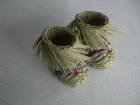 I remember well helping my neighbour with this each year in February. We made balls of the paste and put it in an earthen jar. It then had to be pressed strongly to get the air out of the pot.
I remember well helping my neighbour with this each year in February. We made balls of the paste and put it in an earthen jar. It then had to be pressed strongly to get the air out of the pot.Another form of doing this is to put the paste on a wooden floor, wear straw boots and stamp on it with your feet.
In some areas the paste was then formed into balls and hung from the eaves to dry. When it became autumn, these balls were taken down, split into small pieces and added with salt and yeast (kooji) to prepare the final miso paste.
:::::::::::::::::::::::::::::::::::::::::::::::::::::::::::::::::::::::::::::::::::::::::::::::::::
Hooba miso 朴葉(ほおば)みそ, 朴葉みそ
miso with hooba leaves
from Gifu
often served with Hida beef

WASHOKU
hooba miso, Hoba Miso ほうばみそ miso paste served on a hoba leaf hooba 朴葉 ... Magnolia obovata
::::::::::::::::::::::::::::::::::::::::::::::::::::::::::::::::::::::::::::::::::::::::::::::::::::
hatchoo miso 八丁味噌 "eighth street miso"
from Ozaki
hatcho-miso
quote
Hatcho Miso has a unique flavour which is made from high-quality soybeans, salt and water. Cooked and mashed soybeans are shaped into small balls and mixed with salty water. Then the Miso ferments for 3 winters. Hatcho Miso is made by the Hatcho Miso Company in Hatcho (Eighth street), to the west of Okazaki castle. The name Hatcho is taken from this location. In the Meiji era, Hatcho Miso became the daily choice of the Emperor of Japan.
Hatcho Miso is less in water and salt content. It is easy to digest due to the aminolysis of the soy protein and is high in vitamins and minerals. Hatcho Miso is a natural food since neither food additives nor pasteurisation is used. Miso has yeast fungi which need carbohydrates, the right temperature and enzymes. Summer in the Tokai area(the middle part of Japan) is hot and the hot weather accelerates yeast fungi fermentation very quickly in kome (rice)-miso or mugi (barley)-miso. Thus Hatcho Miso developed mame (beans)-miso which contains less carbohydrates and tolerates the hot weather much better. Hatcho Miso was Tokugawa Ieyasu's favourite and his armies were supplied with the miso because it can be stored for quite a while and can be portable due to its reduced water content. It also has been taken on Japanese expeditions to the South Pole.
History
Hatcho is the place where Hatcho Miso originated and it is "hatcho= eight cho"(cho is an old unit of length used in Japan to measure distance: one cho is equal to 108 metres) away from Okazaki castle where Tokugawa Ieyasu, who founded the Edo feudal government, lived. The Hatcho is located on the banks of the Yahagi River, as it was easy to transport soybeans and sea salt there. Also Hatcho is the best place where high-quality springwater is easily accessible from the granitoid ground in Okazaki and is endowed with the right temperature and suitable humidity in order to make Hatcho Miso. Yahagi soybeans or Nanbu soybeans (Touhoku) and Aiba salt (Kira at the mouth of Yahagi River) were mainly used back then, however currently the ingredients are from all over the nation such as soybeans from Hokkaido and sea salt from Okinawa.
Salt, lumber for miso vats (considered to be Yoshino cedar) and river stones for piling on miso were transported by ship. Half a shipful of salt was unloaded at this place and the rest was carried to Asuke at the upper reaches of the Yahagi River. The salt was transported on foot or by horse from there to Shiojiri along a road called "shio no michi (The road of salt)". Then the empty ship was loaded with a lot of river stones and brought them back to Hatcho. Thus the river stones used currently are from Asuke. It was paid for by miso as a replacement for money and the ship owner left acertain amount of miso for himself and sold the rest in Osaka or Edo.
We come back to the Hatcho Miso.
Savory Hatcho Miso was well appreciated by Tokugawa's armies due to its mobility and long storage resulted from less salt content. Hatcho Miso spread throughout Edo (now Tokyo) as Tokugawa moved the capital to Edo. It also spread throughout the country due to feudal lords' Mandatory Alternate Residence System in Edo. Nevertheless Hatcho Miso currently holds only a10% share whereas kome-miso (rice miso) takes about 80%. The first biggest damage to Hatcho Miso was because of the Tokyo Earthquake in 1923. White kome-miso was brought from Nagano prefecture in relief supplies to help out victims. Furthermore, the Second World War made Hatcho Miso almost completely disappear by bringing kome-miso into the Kanto area as relief supplies. Although Hatcho Miso disappeared, it got the right to supply the Japanese royal family in 1892 and became the daily choice of the Emperor. Even though the system was abolished in 1954, Hatcho Miso is still the Emperor's favorite miso.
"Akadashi Hatcho Miso" is a combination of Hatcho Miso and shiro-miso.
"Tamari" is a fallout of Hatcho Miso. Tamari is the liquid piled up on top of Hatcho Miso during fermentation. It is preferred in the place where mame-miso is eaten.
Much more is here
source : www.yamasa.org
Hatcho Miso Kyarameru 八丁味噌キャラメル Caramels
. . . CLICK here for Photos !
Hatchoo Miso Aisu 八丁味噌アイス icecream, Miso ice cream
. . . CLICK here for Photos !
:::::::::::::::::::::::::::::::::::::::::::::::::::::::::::::::::::::::::::::::::::::::::::::::::::::
mukashimiso, mukashi miso 昔みそ "Miso like in olden times"
prepared by a family in Nerima, Tokyo
in the old style, whith Japanese ingredients and all made by hand.
:::::::::::::::::::::::::::::::::::::::::::::::::::::::::::::::::::::::::::::::::::::::::::::::::::::
tekkamiso, tekka miso てっかみそ【鉄火味噌】 "red hot miso"
red Hatcho miso, mixed with roasted soy beans and chopped burdock or carrots, fried in oil, with sugar, mirin and chili peppers added.
Yamanashi prefecture
. . . CLICK here for Photos !
it is often prepared to eat on top of a bowl of rice or sold in glas bottles.
Reference : Tekka Miso Condiment
*****************************
Worldwide use
das Miso
Paste aus vergorenen Sojabohnen
Misosuppe
in Miso Eingelegtes (misozuke)
Miso-Seiher (misokoshi)
Mamemiso, das nur aus Sojabohnen,
Komemiso, das aus Sojabohnen und Reis und
Mugimiso, das aus Sojabohnen und Gerste besteht.
wikipedia : Soyabohnenpaste
miso mo fun mo issho ni suru
miso mo kuso mo issho de aru
Gutes und Schlechtes durcheinander mischen.
lit. Miso und Kacke durcheinander mischen.
::::::::::::::::::::::::::::::::::::::::::::::::::::::::::::::::::::::::::::::::::::::::::::::::::::
Miso Minzokugaku 民俗学研究 Volkskunde
(卯・辰の日に味噌を作ること)
Shiga ken, Takashima town 滋賀県高島市
Am Tag des Hasen (u no hi) und des Drachen (tatsu no hi) darf man keine Miso machen.
昔、カツという人が味噌を作ってはいけないといわれている卯・辰の日に味噌をつき、弁当のおかずにしてカツ山で仕事をしていた。すると岩が落ちてきて、下敷きになって死んでしまったという。
http://www.nichibun.ac.jp/YoukaiCard/2363314.shtml
http://www.nichibun.ac.jp/cgi-bin/YoukaiDB2/namazu.cgi?query=%cc%a3%c1%b9
味噌長者
貧しい夫婦のところに、痩せ細ったみずぼらしい旅の坊さんが一夜の宿を求めてきた。夫婦は食事すら差し上げることができないからと断ったが、坊さんがそれでもいいと言ったので、夫婦は快く泊めてあげた。翌日、坊さんは家を去るときに何かを念じながら庭にあった古い瓶の周りを廻った。瓶の中には味噌が入っており、それはいくら使ってもなくならなかった。夫婦はそれを売って味噌長者と呼ばれるほど富裕な暮らしができるようになった。
Hyogo prefecture
巳の日 Tag der Schlange im Juni
6月の巳の日が3つあるときに味噌を煮ると、死んでしまってその味噌を食べないものが出るといわれている。
Miyagi prefecture
異僧,麹味噌
ある夫婦者は常に普門品を読むほど信心篤かったが、家貧しく草鞋をつくって生計を立てていた。ある時異僧が家に来て一夜を乞うた。夫婦は貧しさ故断ったが、僧は主人と寝食を共にしたいと、結局宿泊する事になった。翌朝僧は草履を請い、これを履いてぬかみそ桶の周りを、慈願視衆生福聚無量と唱えて出て行った。その桶を開けると麹味噌になっていた。近所の者にあげても尽きなかった。
Hyogo prefecture
山の婆 The old mountain witch and one grain of miso
和尚さんに言われて、小僧が山へ薪をとりに行った昼に味噌の入った握り飯を食べるとき、味噌を一粒落としてしまった。帰りに小僧は山の婆に襲われた。小僧は和尚さんからもらったお札の力で寺まで逃げ戻った。寺まできた鬼婆を和尚は一粒の味噌に化けさせ、小僧に食べさせた。婆は味噌が化けたものだった。
Iwate prefecture
Shamoji rock 杓子岩
箱神社の近くにある杓子岩は、夜に人が通ると「味噌をくれ」と言って杓子を突き出したので、この名をつけられたという。味噌を持って歩く人もそうはいないだろうから、元々味噌を供えて祭った石かと思われる。
Okayama prefecture
*****************************
Things found on the way
Miso paste called DARUMA
大だるまみそ
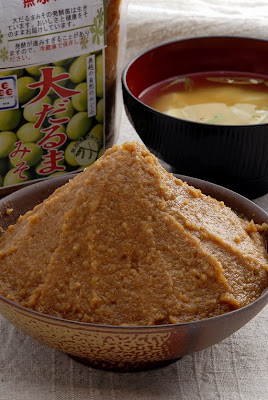
from Fukui, Onoya 平成大野屋
福井県大野市元町1番2号

. "Lucky Ears" (fukumimi 福耳) Miso .
:::::::::::::::::::::::::::::::::::::::::::::::::::::::::::::::::::::::::::::::::::::::::::::::::::::
soba miso そば味噌
with a Daruma Label !
:::::::::::::::::::::::::::::::::::::::::::::::::::::::::::::::::::::::::::::::::::::::::::::::::::::
Miso Jizoo, the Bean Paste Jizo
みそ地蔵, ミソ地蔵, 味噌地蔵
*****************************
HAIKU
寒菊や粉糠のかかる臼の端
kangiku ya ko nuka no kakaru usu no hata - (konuka)
chrysanthemums in the cold -
from the edge of a millstone
rice bran spills over
Tr. Gabi Greve
- Further discussion of this hokku :
. Matsuo Basho 松尾芭蕉 - Archives of the WKD .
. fuyugiku 冬菊 winter chrysanthemum .
:::::::::::::::::::::::::::::::::::::::::::::::::::::::::::::::::::::::::::::::::::::::::::::::::::::::
. WKD : Kobayashi Issa 小林一茶 in Edo .
おのが味噌のみそ臭さをしらず
your own soybean paste is the only one that doesn't stink like soybean paste --
そば国のたんを切つつ月見哉
蕎麦国のたんを切りつつ月見哉
soba-guni no tan wo kiritsutsu tsukimi kana
flying high praising
local buckwheat noodles
they view the moon
Tr. Chris Drake
The proverb given in the headnote refers to the strong smell or mild stink given off by the fermented soybeans used to make miso beanpaste. Most people I know do not like this stink, which these days is reduced by various styles of processing. Thus the proverb is saying that people only smell the stink of others' bean paste and think the stink of their own bean paste is pleasingly fragrant. This proverb is of course used to refer to self-centeredness, egoism, following self-interest, and so on
. Chris Drake - comments on this Issa Haiku .
. WKD : Buckwheat noodles (soba 蕎麦) .
:::::::::::::::::::::::::::::::::::::::::::::::::::::::::::::::::::::::::::::::::::::::::::::::::::::
フウフする 夫婦仲良く お味噌汁
fuufu suru fuufu nakayoku o-misoshiru
blowing it cool -
the old couple slurping
miso soup
Gabi Greve 2005
Couple's Day, Februaray 2
:::::::::::::::::::::::::::::::::::::::::::::::::::::::::::::::::::::::::::::::::::::::::::::::::::::
a haiku blog basically, by ALISON
miso soup
haiku talk -
the orange juice comes with
or without bits
::::::::::::::::::::::::::::::::::::::::::::::::::::::::::::::::::::::::::::::::::::::::::::::::::::
Daruma Miso from Kochi
だるま味噌株式会社

source : kochilove.blog95
. Daruma from Kochi .
*****************************
Related words
***** Tofu (toofu), bean curd Japan
***** Yumiso 柚味噌 (ゆみそ) miso with yuzu citron
WASHOKU : INGREDIENTS
hachoo
:::::::::::::::::::::::::::::::::::::::::::::::::::::::::::::::::::::::::::::::::::::::::::::::::::
